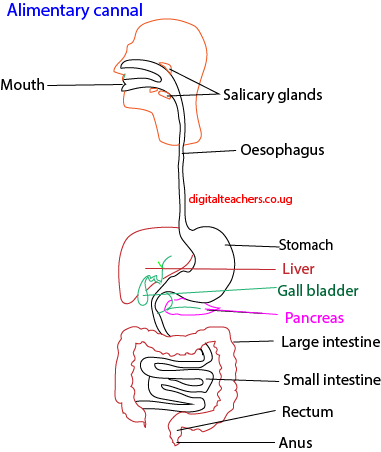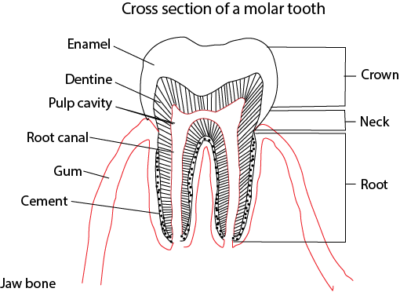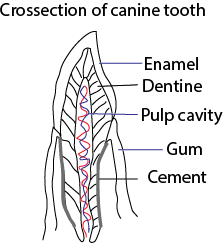
Digestion- upper primary science

Digestion
This is the process of breaking down food into smaller particles that can be absorbed and used in the body.
The following are reasons why our bodies need food:
- To change the food to energy which is used by the body for movement, for blood circulation ,breathing ,etc. we need to take in carbohydrates and fats to provide the energy.
- To keep us warm and maintain our body temperature at 370C which is above the temperature of our surrounding of our surrounding .carbohydrates and fats are needed to provide the heat to the body.
- We needed to take in proteins that will be used to build new flesh ,new bones and new muscles .we also need proteins to help in body repair and
- We need to take in vitamins and mineral salt to protect our bodies from diseases.
Human digestive system

Parts of the digestive system
The digestive system comprises of the;
- Mouth
- Gullet / Esophagus
- Stomach
- Small intenstines
- Large intestine
- Anus
- Small intestine
- Pancreas and rectum
NB. Liver and pancreas are not part of alimentary canal but play a role in digestion.
Mouth
What function does the mouth play in digestive?
The mouth has teeth, the jaw, the tongue and saliva.
- The jaw holds the teeth.
- The teeth crush food into smaller pieces
- Saliva has amylase enzyme that breaks starch to maltose
- Saliva contain mucus that lubricate food and making it easier to swallow.
- The tongue rolls up and mixes food with saliva for easy swallowing.
- The tongue helps during swallowing by pushing the food to the back of the mouth.
- The tongue tastes and discriminate bad food
Sets of teeth
A person has two sets of teeth. The first set is the milk teeth also called the deciduous teeth. The set consists of incisors, canines and premolar only .The total number of milk teeth is 20.
The second set is composed of 32 teeth. This set is called the permanent teeth and it replaces the milk teeth. The permanent set of teeth consists of four types of teeth.
Types of teeth
There are four different types of teeth.
- Incisors for nipping, cutting and biting.
- Canines for biting, cutting and tearing.
- Premolars for crushing, chewing and grinding.
- Molar for crushing ,chewing and grinding
Drawing of teeth

Characteristics of teeth and their functions
| Type of tooth | Features | Functions of the tooth | Number in adult |
| Incisor | Has one root
It is chisel-shaped |
Biting and cutting | 8 |
| Canine | Has one root
It is sharp and pointed |
For tearing | 4 |
| Premolar | It has two roots
Has uneven top |
Crushing food
Grinding food Chewing food |
8 |
| Molar | Has three roots
Has uneven top |
Crushing food
Grinding food Chewing food |
12 |


Teeth are made of a very hard substance called dentine, which in turn is covered by even a harder substance called enamel made of calcium and phosphate salts.
The part of teeth called pulp cavity carries blood vessels to provide nutrients and oxygen to the teeth. The pulp cavity also carries nerves.
Teeth and mouth diseases
- Dental caries
- Mouth ulcers
- Bleeding gum
- Bad breath
Care of teeth
- Teeth be brushed/cleaned after every meal to prevent tooth decay. Tooth decay is caused by food remains that remain in the mouth in between the teeth and gum after feeding.
- Avoid eating sugary foods such as sweet and biscuits or drinking sugary juice.
- Visit a dentist in case of any problem
- Eat food that contain calcium such as milk and eggs
Gullet
It connects the mouth with the stomach
Food moves through the gullet to the stomach by peristalsis.
Stomach
The stomach is like an elastic bag that keeps food temporarily. It mixes the food continuously and releases a small amount of it at a time into the intestines.
Functions of the stomach
- Acts as a temporary store for food.
- Produce enzymes that digest proteins.
- Produce hydrochloric acid that kills germs
- Absorbs food like glucose, vitamins, and ehtanol
- Pounds food into small particles for easy digestion
INTESTINES
They intestine is divided into the small intestine and the large intestine.
The small intestine
The small intestine is a long narrow tube between the stomach and the large intestine where:
- Digestion of food takes place.
- Water and nutrients from the food are absorbed into the blood.
- Undigested materials are pushed into the large intestine.
The large intestine
Functions of the large intestine include:
- To absorb most of the water still remaining in the undigested food.
- Holding undigested materials that form the feces which are pushed
Other organs of digestion
Pancreas
Produces pancreatic juice into the small intestines which continues the digestion of proteins found in foods like meat and starch found in foods like maize. It also begins the digestion of fats and oils.
Liver
Produces bile that emulsifies or breaks down fats into small particles.
It stores vitamins and minerals. It also controls the amount of sugar in the body.
Rectum
It holds the undigested material (waste matter) and releases it to the anus.
Anus
Passes out the undigested material out of the body.
Disease that affect the alimentary canal
- Cholera
- Dysentery
- Peptic ulcers
- Worms
- Cancer
Caring for alimentary canal
- Wash your hands before eating food
- Do not move bare footed
- Eat balanced diet at regular interval
- Regularly deworm yourself
- Drink enough fluids.
For revision question download PDF
Digestive system (upper primary)

Good notes
Best notes
I’m always inspired by your words. Computer & Accessories
You have a gift for explaining things clearly. TamilBlasters Com
Secure a seamless admission process with MBBS Direct Admission in Rajasthan.
Explore cost-saving options for aspiring doctors with MBBS Fees Structure in Sikkim.
Install the Raja Luck App and explore exciting gaming options.
I LIKE THE NOTES